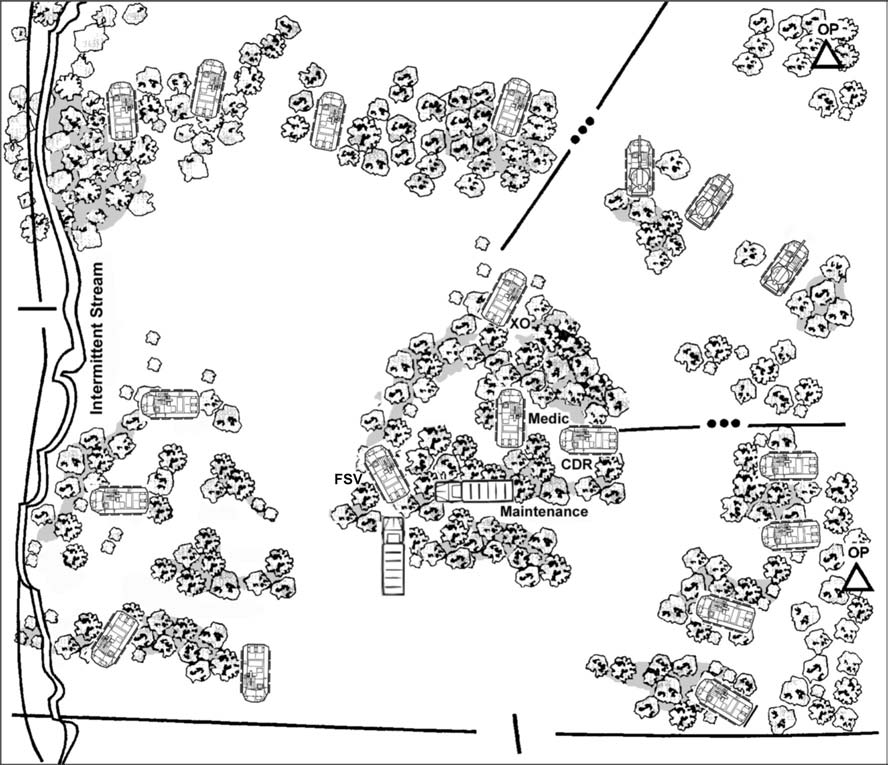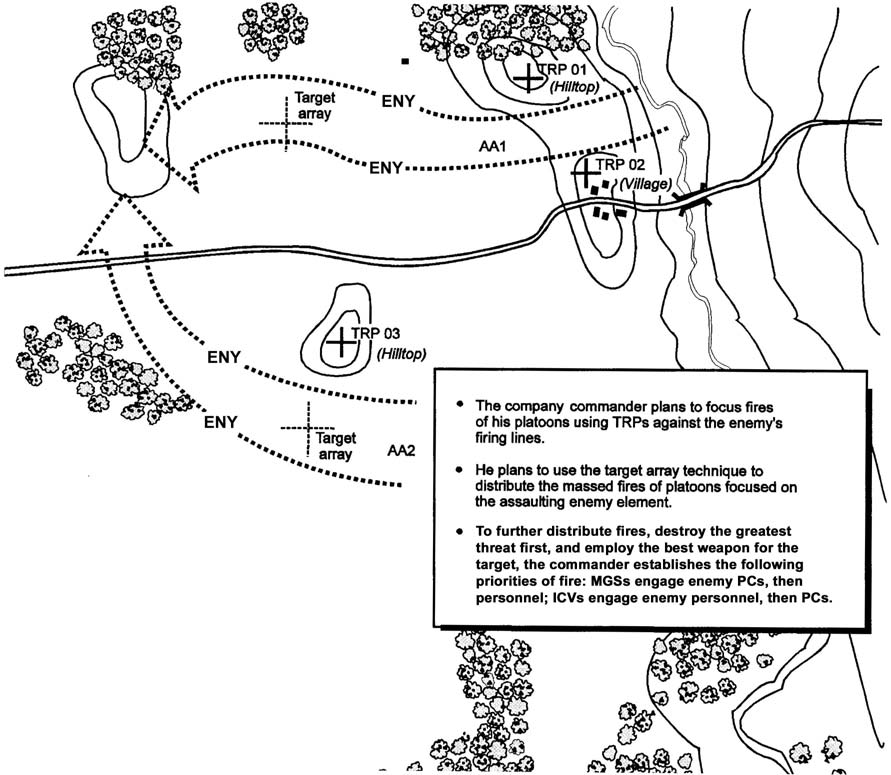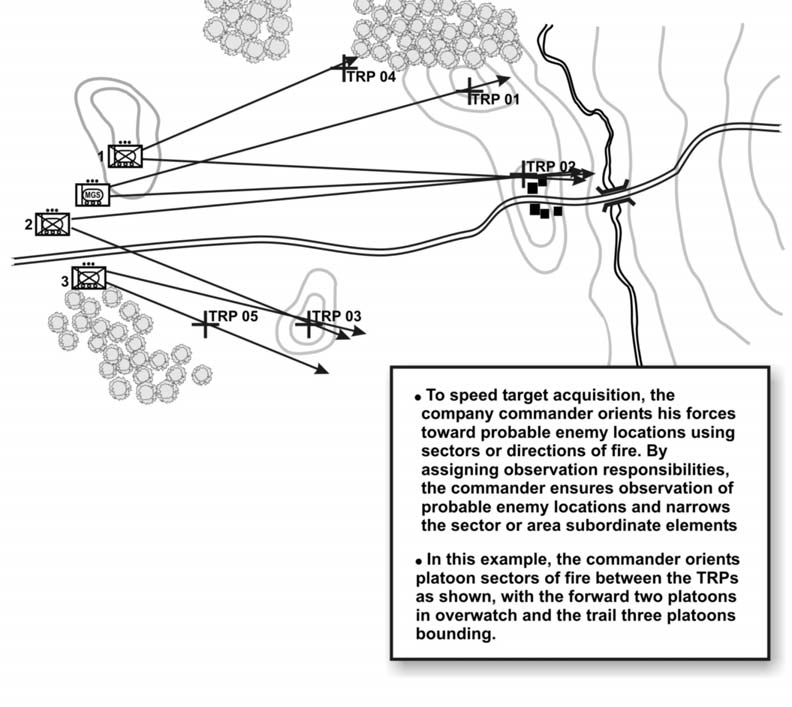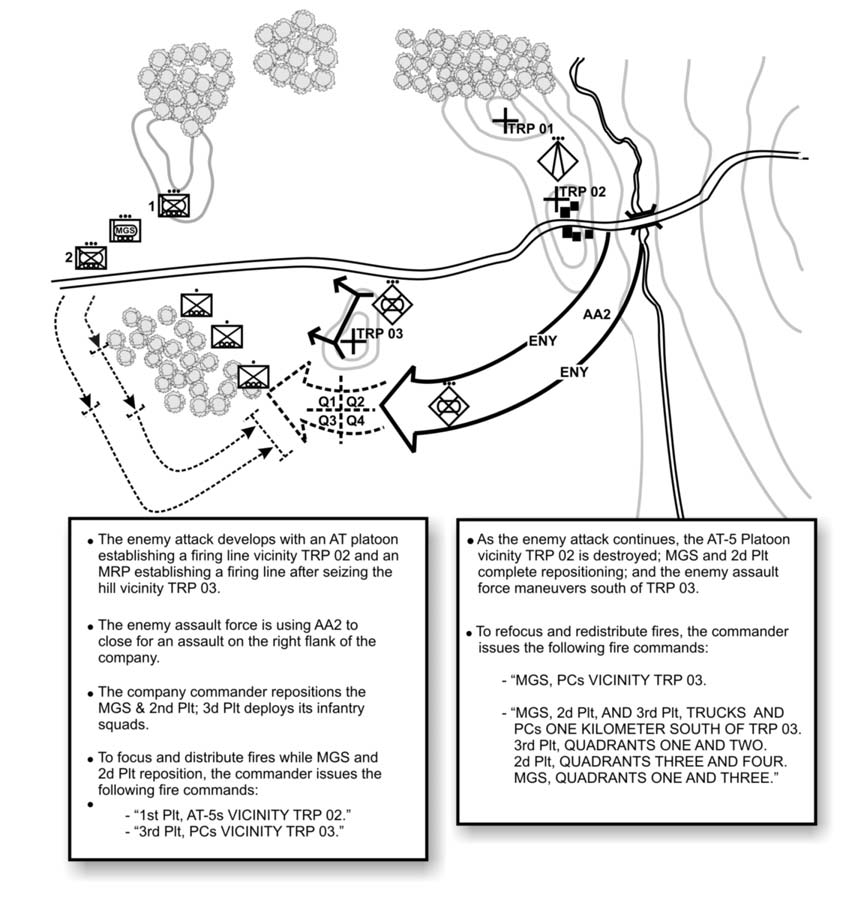G-5

FM 3-21.11
Figure G-1. SBCT infantry company assembly area example.
G-10. ACTIONS IN THE ASSEMBLY AREA
Following occupation, the SBCT infantry company and its individual elements can prepare for future operations by conducting troop-leading procedures and priorities of work in accordance with battalion and company OPORDs. These preparations include the following:
• Establish and maintain security (at the appropriate REDCON level).
• Employ infantry squads to implement security measures as necessary, including protection against enemy infiltration.
• Conduct TLP.
• Perform maintenance on vehicles and communications equipment.
• Verify weapons system status and conduct test firing and other necessary preparations. (The SBCT infantry company normally must coordinate test-firing activities with its higher headquarters.)
• Conduct resupply operations, including refueling and rearming.
• Conduct rehearsals and other training for upcoming operations.
• Conduct PCCs and PCIs based on time available.
• Adjust SBCT infantry company task organization as necessary.
G-6
FM
3-21.11
• Account for company personnel and assigned sensitive items.
• Reestablish vehicle load plans.
G-7
FM
3-21.11
APPENDIX H
DIRECT FIRE PLANNING AND CONTROL
Suppressing or destroying the enemy with direct fires is fundamental to success in close combat. Effective direct fires are the unique contribution of maneuver forces to the combined arms team, and fire and movement are complementary components of maneuver. The SBCT
infantry company commander must effectively plan to focus, distribute, and shift the overwhelming mass of his direct fire capability at critical locations and times to be successful on the battlefield. These resources include dismounted infantry, ICVs, and MGS vehicles. Effective and efficient fire control means that the company acquires the enemy rapidly and masses the effects of direct fires to achieve decisive results in the close fight.
Section I. PRINCIPLES OF DIRECT FIRE CONTROL
When planning and executing direct fires, the SBCT infantry company commander and subordinate leaders must know how to apply several fundamental principles. The purpose of these direct fire control principles is not to restrict the actions of subordinates, but to help the company accomplish the primary goal of any direct fire engagement: to eliminate the enemy by acquiring first and shooting first. Applied correctly, these principles give subordinates the freedom to respond rapidly upon acquisition of the enemy. This discussion focuses on the following principles:
• Mass the effects of fire.
• Destroy the greatest threat first.
• Avoid target overkill.
• Employ the best weapon for the target.
• Minimize friendly exposure.
• Prevent fratricide.
• Plan for extreme limited visibility conditions.
• Develop contingencies for diminished capabilities.
H-1. MASS THE EFFECTS OF FIRE
The SBCT infantry company must mass its direct fires to achieve decisive results.
Massing entails focusing direct fires at critical points and distributing the effects.
Random application of fires is unlikely to have a decisive effect. For example, concentrating the company’s fires at a single target may ensure its destruction or suppression; however, that fire control option will fail to achieve the decisive effect on the enemy formation or position.
H-2. DESTROY THE GREATEST THREAT FIRST
The order in which the SBCT infantry company engages enemy forces is in direct relation to the danger these forces present. The threat posed by the enemy depends on his weapons, range, and positioning. Presented with multiple targets, a unit must initially
H-1
FM 3-21.11
concentrate direct fires to destroy the greatest threat, then distribute fires over the remainder of the enemy force.
H-3. AVOID TARGET OVERKILL
Use only the amount of fire required to achieve necessary effects. Target overkill wastes ammunition and is not tactically sound. To the other extreme, the company cannot have every weapon engage a different target because the requirement to destroy the greatest threats first remains paramount.
H-4. EMPLOY THE BEST WEAPON FOR THE TARGET
Using the appropriate weapon for the target increases the probability of rapid enemy destruction or suppression; at the same time, it conserves ammunition. The SBCT
infantry company has many weapons with which to engage the enemy. Target type, range, and exposure are key factors in determining the weapon and ammunition that should be employed, as are weapons and ammunition availability and desired target effects. Additionally, a leader must consider more than only the capabilities of dismounted infantry squads and ICVs. He also must determine how to best employ his MGS platoon. The company commander arrays his forces based on the terrain, enemy, and desired effects of all of his available direct fires. As an example, when he expects an enemy dismounted assault in restricted terrain, the company commander employs his dismounted infantry squads, taking advantage of their ability to engage numerous, fast-moving dismounted targets.
H-5. MINIMIZE FRIENDLY EXPOSURE
Units increase their survivability by exposing themselves to the enemy only to the extent necessary to engage him effectively. Natural or manmade defilade provides the best cover from ATGMs and other large caliber direct fire munitions. Dismounted infantry and vehicles minimize their exposure by constantly seeking effective available cover, attempting to engage the enemy from the flank, remaining dispersed, firing from multiple positions, and limiting engagement times.
H-6. PREVENT
FRATRICIDE
The company commander must be proactive in reducing the risk of fratricide and noncombatant casualties. He has numerous tools to assist him in this effort: FBCB2, identification training for combat vehicles and aircraft, the unit’s weapons safety posture, the weapons control status, and recognition markings. Knowledge and employment of applicable ROE are the primary means of preventing noncombatant casualties.
H-7. PLAN FOR EXTREME LIMITED VISIBILITY CONDITIONS
At night, limited visibility fire control equipment enables the SBCT infantry company to engage enemy forces at nearly the same ranges that are applicable during the day.
Obscurants such as dense fog, heavy rain, heavy smoke, and blowing sand, however, may reduce the capabilities of thermal and IR equipment. It also may add confusion to information provided by FBCB2. Therefore, the company commander should develop contingencies for such extreme limited visibility conditions. Although decreased acquisition capabilities have minimal effect on area fire, point target engagements are H-2
FM 3-21.11
likely to occur at decreased ranges. Firing positions, whether offensive or defensive, typically must be adjusted closer to the area or point where the commander intends to focus fires. Another alternative is the use of visual or IR illumination when there is insufficient ambient light for passive light intensification devices.
H-8. DEVELOP
CONTINGENCIES
FOR DIMINISHED CAPABILITIES
Leaders initially develop plans based on their units’ maximum capabilities; they make backup plans for implementation in the event of casualties, weapon damage or failure, or loss of the COP. While leaders cannot anticipate or plan for every situation, they should develop plans for what they view as the most probable occurrences. Building redundancy into these plans, such as having two systems observe the same sector, is an invaluable asset when the situation (and the number of available systems) permits. Designating alternate sectors of fire provides a means of shifting fires if adjacent elements become unable to fire.
Section II. FIRE CONTROL PROCESS
To bring direct fires against an enemy force successfully, commanders and leaders must continuously apply the four steps of the fire control process. At the heart of this process are two critical actions: rapid, accurate target acquisition and the massing of fires to achieve decisive effects on the target. Target acquisition is the detection, identification, and location of a target in sufficient detail to permit the effective employment of weapons. Massing entails focusing fires at critical points and then distributing the fires for optimum effect. The four steps are--
• Identify probable enemy locations and determine the enemy scheme of maneuver.
• Determine where and how to mass (focus and distribute) fire effects.
• Orient forces to speed target acquisition.
• Shift fires to refocus or redistribute their effects.
H-9. IDENTIFY PROBABLE ENEMY LOCATIONS AND DETERMINE THE
ENEMY SCHEME OF MANEUVER
The SBCT infantry company commander plans and executes direct fires based on his analysis of the factors of METT-TC. In particular, his analyses of the terrain and the enemy force are essential and aid him in visualizing how the enemy will attack or defend a particular piece of terrain. A defending enemy’s defensive position or an attacking enemy’s support position is normally driven by terrain. Typically, there are limited points on a piece of terrain that provide both good fields of fire and adequate cover for a defender. Similarly, an attacking enemy will have only a limited selection of avenues of approach that provide adequate cover and concealment. Coupled with awareness gained through FBCB2, the company commander’s understanding of the effects of a specific piece of terrain on maneuver assist him in identifying probable enemy locations and likely avenues of approach both before and during the fight. Figure H-1, page H-4, illustrates the commander’s analysis of enemy locations and scheme of maneuver. He may use any or all of the following products or techniques in developing and updating the analysis:
H-3

FM 3-21.11
• A SITEMP provided by the battalion.
• A SPOTREP or contact report on enemy locations and activities.
• Reconnaissance of the area of operations.
Figure H-1. Identifying probable enemy locations and determining enemy scheme of maneuver.
H-10. DETERMINE WHERE AND HOW TO MASS FIRES
To achieve decisive effects, the SBCT infantry company must mass direct fires. Effective massing requires the company commander both to focus the fires of subordinate elements and to distribute the effects of those fires. Based on his analysis and his concept of the operation, the company commander identifies points where he wants to--or must--focus the company's direct fires. Most often, he has identified these locations as probable enemy positions or points along likely enemy avenues of approach where the company can mass direct fires. Because the platoons may not initially be oriented on the point where the commander wants to mass direct fires, he may issue a fire command to focus H-4

FM 3-21.11
the fires. At the same time, the company commander must use direct fire control measures to effectively distribute the direct fires of his subordinate elements, which are now focused on the same point. Figure H-2 illustrates how the commander masses fires against the enemy.
Figure H-2. Determining where and how to mass (focus and distribute) fire effects to kill the enemy.
H-11. ORIENT FORCES TO SPEED TARGET ACQUISITION
To engage the enemy with direct fires effectively, the SBCT infantry company must rapidly and accurately acquire enemy elements. Orienting the company on probable enemy locations and on likely enemy avenues of approach speeds target acquisition.
Conversely, failure to orient the company results in slower acquisition, which greatly increases the likelihood that enemy forces will be able to engage first. The SBCT infantry company commander receives information that enhances his awareness primarily by FBCB2, but he has other methods to reinforce FBCB2 information. The clock direction orientation method, which is prescribed in most unit SOPs, is good for achieving all-round security, but it does not ensure that friendly forces are most effectively oriented to detect the enemy. To achieve this critical orientation, the commander typically designates
H-5

FM 3-21.11
TRPs on or near a probable enemy location or avenues of approach and orients his platoons using directions of fire or sectors of fire. Normally, some ICVs and MGS
vehicles scan the designated direction, sector, or area while others observe alternate sectors or areas to provide all-round security. Figure H-3 illustrates how the company commander orients the company for quick, effective acquisition of the enemy force.
Figure H-3. Orienting forces to speed target acquisition.
H-12. SHIFT FIRES TO REFOCUS AND REDISTRIBUTE
As the engagement proceeds, leaders must shift direct fires to refocus and redistribute the effects based on evolving friendly and enemy information. Figure H-4 provides an example of shifting to refocus and redistribute fires. The SBCT infantry company commander and his subordinate leaders apply the same techniques and considerations that they used earlier to focus and distribute fires, including fire control measures. A variety of situations dictate shifting of fires, including the following:
• Appearance of an enemy force posing a greater threat than the one currently being engaged.
• Extensive destruction of the enemy force being engaged, creating the possibility of target overkill.
• Destruction of friendly elements that are engaging the enemy force.
H-6

FM 3-21.11
• Change in the ammunition status of friendly elements that are engaging the enemy force.
• Maneuver of enemy or friendly forces resulting in terrain masking.
• Increased fratricide risk as a maneuvering friendly element closes with the enemy force being engaged.
Figure H-4. Shifting to refocus and redistribute fires.
Section III. DIRECT FIRE PLANNING
The SBCT infantry company commander plans direct fires concurrent with his troop-leading procedures. Determining where and how the company can and will mass fires is an essential step as the commander develops his concept of the operation.
H-7
FM 3-21.11
H-13. PLANNING DIRECT FIRES
After identifying probable (or known) enemy locations, the SBCT infantry commander determines points or areas where he will focus his combat power. His situational understanding (or visualization) of where and how the enemy will attack or defend assists him in determining the volume of fires he must focus at particular points to have a decisive effect. In addition, if he intends to mass the direct fires of more than one platoon, he must establish a means for distributing those fires effectively.
a. Based on where and how he wants to focus and distribute direct fires, the commander can establish the weapons ready postures for company elements as well as triggers for initiating fires. The company commander uses the tactical information provided by FBCB2. He must evaluate the risk of fratricide and establish controls to prevent it. Fratricide prevention measures include designation of recognition markings, weapons control status, and weapons safety posture.
b. Having determined where and how he will mass and distribute direct fires, the company commander must orient platoons so they can rapidly and accurately acquire the enemy. The commander must anticipate how the enemy will fight. He gains this anticipation through a detailed war-game of the selected course of action to determine probable requirements for refocusing and redistributing fires and to establish other necessary controls. Also during the troop-leading procedures, the company commander plans and conducts rehearsals of direct fires (and of the fire control process) based on his analysis.
c. The company commander must continue to apply planning procedures and considerations throughout execution. He must be able to adjust direct fires based on combining the latest available tactical information from FBCB2. When necessary, he must also apply effective direct fire SOPs, which are covered in the following discussion.
H-14. DIRECT FIRE SOP
A well-rehearsed direct fire SOP enhances direct fire planning and ensures quick, predictable actions by all members of the company. The SBCT infantry company commander bases the various elements of the SOP on the capabilities of his force and on anticipated conditions and situations. SOP elements should include standing means for focusing fires, distributing their effects, orienting forces, and preventing fratricide. The commander should adjust the direct fire SOP whenever changes to anticipated and actual factors of METT-TC become apparent.
a. Focusing Fires. FBCB2 enhances a company commander’s ability to focus the direct fires of his platoons, but he also needs other means, such as TRPs, to do so. One technique is to establish a standard respective position for TRPs in relation to friendly elements and then to consistently number the TRPs, such as from left to right. This allows leaders to quickly determine and communicate the location of the TRPs.
b.
Distributing Fires. Two useful means of distributing the effects of the company’s direct fires are engagement priorities and target array. Engagement priorities, by type of enemy vehicle or weapon, are assigned for each type of friendly weapon system. The target array technique can assist in distribution by assigning specific friendly elements to engage enemy elements of approximately similar capabilities. The following are example SOP elements for distributing the fires of an SBCT infantry company moving mounted in a wedge formation:
H-8
FM 3-21.11
• MGSs engage medium-armored vehicles first, then tanks.
• ICVs engage antitank weapons first, then trucks.
• Javelins engage tanks first, then other armored vehicles.
• Dismounted infantry engage crew-served weapons, then infantry.
• If the company masses fires at the same target, then the MGS platoon engages enemy armored vehicles, the left flank infantry platoon engages the left half of the enemy formation, and the right flank infantry platoon engages the right half of the enemy formation. The trail infantry platoon remains in reserve.
c. Orienting Forces. A standard means of orienting friendly forces is to assign a primary direction of fire, using a TRP, to orient each element on a probable (or known) enemy position or likely avenue of approach. To provide all-round security, the SOP can supplement the primary direction of fire with sectors using a friendly-based quadrant.
The following example SOP elements illustrate the use of these techniques: (1) The front (center) platoon’s primary direction of fire is TRP 2 (center) until otherwise specified; the platoon is responsible for the front two quadrants.
(2) The left flank platoon’s primary direction of fire is TRP 1 (left) until otherwise specified; the platoon is responsible for the left two friendly quadrants (overlapping with the center platoon).
(3) The right flank platoon’s primary direction of fire is TRP 3 (right) until otherwise specified; the platoon is responsible for the right two friendly quadrants (overlapping with the center platoon).
(4) The trail platoon’s primary direction of fire is TRP 3 (right) until otherwise specified; the platoon is responsible for the bottom right friendly quadrant (overlapping with the right platoon).
d. Preventing Fratricide. FBCB2 is a good tool for minimizing fratricide risk but does not supplant the company commander’s responsibility to plan for fratricide prevention. The SOP must address the most critical requirement of fratricide prevention with or without FBCB2. It must direct subordinate leaders to inform the commander, adjacent elements, and subordinates whenever a friendly force is moving or preparing to move. One technique is to establish a standing weapons control status of WEAPONS
TIGHT, which requires positive enemy identification prior to engagement. The SOP must also cover means for identifying dismounted infantry squads and other friendly dismounted elements. Techniques include using arm bands, medical heat pads, or an IR
light source, as well as detonating a smoke grenade of a designated color at the appropriate time.
Section IV. DIRECT FIRE CONTROL
Acquiring the enemy is a precursor to direct fire engagement. The company commander must not assume that his unit will always be able to see the enemy through FBCB2. He must expect the enemy to use cover and concealed routes effectively when attacking and to make best use of flanking and concealed positions in the defense. As a result, the company may not have the luxury of a fully exposed enemy that it can easily see. The acquisition of the enemy often depends on visual recognition of very subtle indicators, such as exposed antennas, reflections from the vision blocks of enemy vehicles, small dust clouds, or smoke from vehicle engines or ATGM or tank fires. Because of the difficulty of target acquisition, the company commander must develop surveillance plans
H-9
FM 3-21.11
to assist the company in acquiring the enemy. The information he gains can then be shared with others through FBCB2.
H-15. FIRE CONTROL MEASURES
Fire control measures are the means by which the SBCT infantry company commander or his subordinate leaders control direct fires. Application of these concepts, procedures, and techniques assists the unit in acquiring the enemy, focusing fires on him, distributing the effects of the fires, and preventing fratricide. At the same time, no single measure is sufficient to control fires effectively. At company level, fire control measures are effective only if the entire unit has a common understanding of what they mean and how to employ them. Table H-1 lists terrain-based and threat-based fire control measures.
Terrain-Based Fire Control Measures
Threat-Based Fire Control Measures
Target reference point
Fire patterns
Engagement area
Target array
Sector of fire
Engagement priorities
Direction of fire
Weapons ready posture
Terrain-based quadrant
Engagement criteria
Friendly-based quadrant
Weapons control status
Maximum engagement line
Rules of engagement
Restrictive fire line
Weapons safety posture
Final protective line
Engagement techniques
Table H-1. Common fire control measures.
a.
Terrain-Based Fire Control Measures. The SBCT infantry company commander uses terrain-based fire control measures to focus and control fires on a particular point, line, or area rather than on a specific enemy element. The following paragraphs describe the techniques associated with this type of control measure.
(1) Target Reference Point. A target reference point is an easily recognizable point on the ground that leaders use to orient friendly forces and to focus and control direct fires. In addition, when TRPs are designated as indirect fire targets, they can be used in calling for and adjusting indirect fires. Leaders designate TRPs at probable (or known) enemy locations and along likely avenues of approach. TRPs can be natural or manmade and can be established sites, such as hills or buildings, or impromptu features designated as TRPs on the spot, like burning enemy vehicles or smoke generated by an artillery round. Ideally, TRPs should be visible in three observation modes (unaided, passive-IR, and thermal) so all forces can identify them. Example of TRPs include the following features and objects:
• Prominent hill mass.
• Distinctive building.
• Observable enemy position.
• Destroyed vehicle.
• Ground-burst illumina








